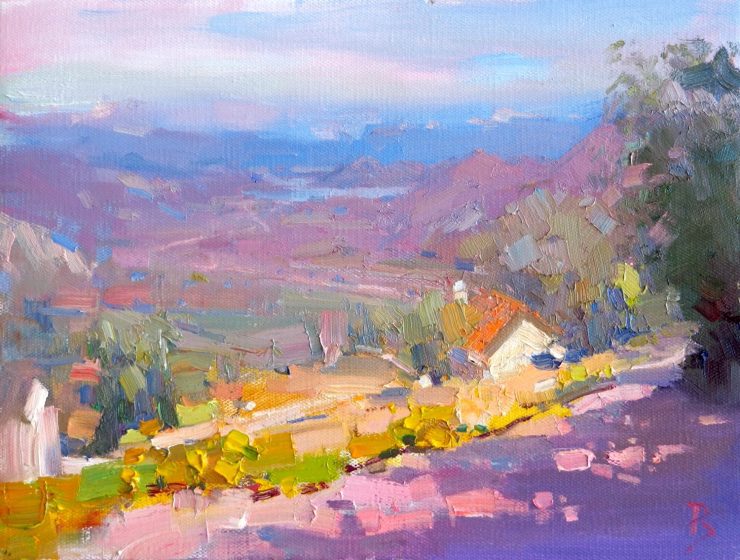Table of Contents
Toggle(Get free painting tips and plein air painting techniques sent straight to your inbox or on my social media.)
What is the Rule of Thirds In Art?
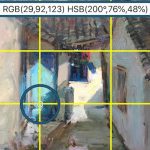
The rule of thirds is a guideline for both artists and photographers. It says that if you divide your composition into thirds, either vertically or horizontally, and then place focal areas of your scene at the meeting points of them, you will get a more pleasing arrangement and layout for your compositions.
Details: The Rule of Thirds In Art
Composition is one of the most important things you need to plan in your painting whether you are painting landscapes, still lifes, or painting the figure and portrait. It determines the success or failure of your painting.
An important technique you should know about is the Rule of Thirds. Although this is often referred to as a rule, I prefer to call it a technique. This is because making it a rule is too rigid: there are ways of making good compositions without using this principle. However for beginners, the rule of thirds is a good guideline.
The rule of thirds relates to another principle called the “Golden Ratio”. This is a mathematical relationship of proportion that is often found in nature. This ratio has been used by artists and architects throughout the centuries, including the designers of the Parthenon in Athens, Salvador Dali, Le Corbusier, and Leonardo da Vinci.
Example Of The Rule Of Thirds
Here is one of my paintings of an old wooden house in a Chinese village called Xinchang, near Shanghai. I painted this during an event in which Chinese and American painters were invited to participate in a week-long plein air event with a final exhibition in an old historic building in the ancient village.
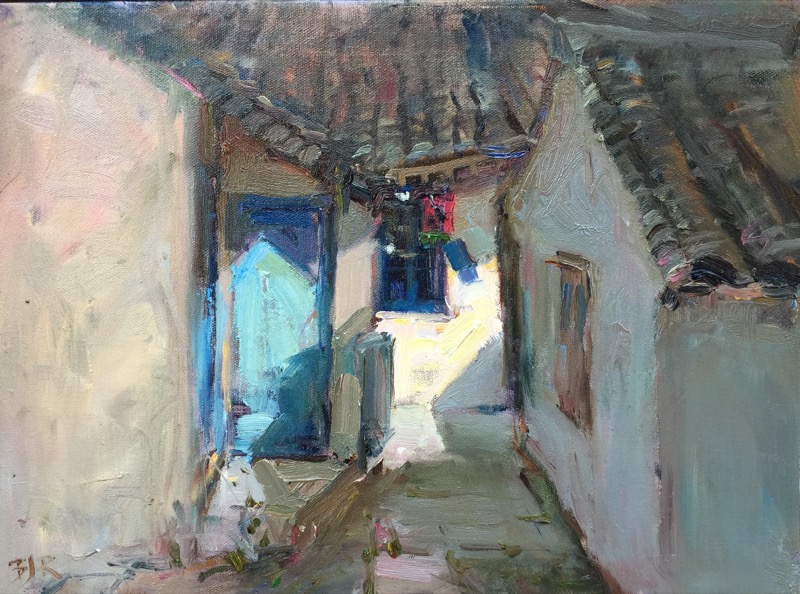
Note where the most saturated color is: the light on the blue door. This is an example of a focal area. Now to see the rule of thirds in action, let’s add a grid over the painting that is divided in to thirds.
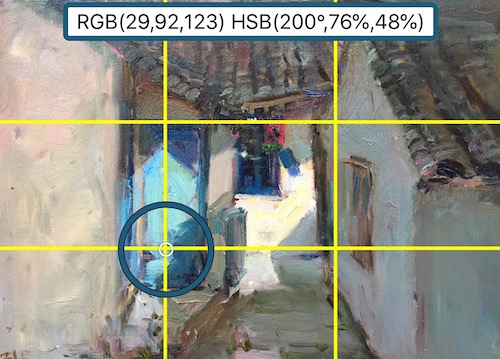
You can see that the blue door lies on the line of the first third division in the painting. In this case it does not lie at the intersection of the gridlines, but along one of them. If you have a small focal area or focal point, you could put it at the intersection. A longer focal area such as this one falls along one of the lines.
The circle shows the intersection of the division of thirds. The HSB shows the saturation of the blue color: 76%, which is quite high. I am using the principle of contrast of saturation to highlight the focal area.
In this way, by using the rule of thirds in art you can make your paintings more interesting.
Using Apps To Apply The Rule Of Thirds In Art
There are several apps you can use on your phone to put a grid on top of a photograph to identify the positions where the third division points lie. If you search the app store for ‘photo grids’ you will find them. I use an app called Grid #. This one has worked quite well for me.
Origins Of The Rule Of Thirds In Art History
The origins of the rule of thirds go back to classical Greek Architecture to and Renaissance paintings. It is also commonly used as a compositional tool by photographers. If you examine many classical buildings and Renaissance paintings you will see how often the main characters are placed at the intersection of the third division lines. However, it is not always the case and be cautious not to be too dogmatic about this rule. There are often other, more important things to think about in composition such as rhythm and groupings that might override this rule. As always, the rule of thirds is just a technique in your toolbox, and not to be always followed religiously.
Relationship Of The Rule Of Thirds In Art To Other Principles Of Art
I suspect that this rule is more of a simple way to avoid putting your focal area, or center of interest, right in the center of the painting, rather than a prescription of exactly where to place it. It is never a good idea to put the most interesting part of the painting in the dead center of your painting.
Also, it probably works because a division of two thirds 0.66 approximates to the concept of a golden ratio which is a ratio of 0.62. The Golden Ratio is a pleasing division of space as it is based on natural mathematical laws.
Here is a video by Apple showing how to use an iPhone to view the rule of thirds grids.
For More Information
For more information on the principles of art, see the Guide to Composition. Also see the article on the Rule of Thirds in Wikipedia.
Thank You
Thank you for taking the time to read this article. I hope you find it useful. If you would like to get free painting tips by email, please sign up for my free tips newsletter.
If you are interested in a structured approach for learning how to paint, take a look at my online painting classes.
Happy painting!
Barry John Raybould
Virtual Art Academy
What The Students Are Saying
Fantastic lesson plans, and a vibrant community
The Virtual Art Academy is the perfect art course I’ve been searching for. Barry’s decades of knowledge are condensed into fantastic lesson plans, creating a vibrant community. The apprentice course delves deep into drawing, painting planning, and color theory. It’s like obtaining an art degree at my own pace and more affordably. The structured format encourages interaction and feedback, enhancing the learning experience. Overall, a fulfilling way to study art from home.
Since I started the programme I can see improvements in my composition and use of colour

I have been working through the VAA course for over five years and would highly recommend it to anyone wanting to improve their painting. There is a huge amount of information on the site and it is well presented and regularly updated and added to. When other members have commented on work I have posted I have found it really useful. When I review my work over the time since I started the programme I can see improvements in my composition and use of colour.
Read more “Since I started the programme I can see improvements in my composition and use of colour”
An excellent foundation on so many aspects of painting

When I got word of the course available through Virtual Art Academy, I was very excited for the opportunity to learn what I never knew about painting. VAA has provided me an excellent foundation on so many aspects of painting. The course is organized very logically, provides great examples, diagrams, thorough explanations and worthwhile assignments. I highly recommend this course to anyone with a desire for an in-depth education of art.
Thank you again, Barry, I love this course Jeanne
Read more “An excellent foundation on so many aspects of painting”
Building blocks of learning is the best I have seen

Read more “Building blocks of learning is the best I have seen”
I’m Richard Robinson …. best online art training available on the internet today

In my opinion Barry has created the best online art training available. I found the Virtual Art Academy course of painting lessons many years ago and was so inspired by it that I contacted the author and got to know him personally.
Two Critical Keys
If you are looking (like I did) for the best painting course available there are two key things you should know about the Virtual Art Academy course which make it stand out above the other online painting courses available today:
1. It’s Comprehensive.
It covers ALL the key painting concepts and then goes further, revealing more and more painting insights. Most courses miss a LOT out – this one doesn’t.
2. It’s easy to understand.
All that information could easily become confusing, but each piece is laid out clearly and concisely using Information Mapping® making it a pleasure to learn.
If you can find another painting course which does these 2 things better, please let me know. As I said, I have been searching for many years and continue to do so, so you could save yourself a lot of precious time and money by joining the Virtual Art Academy today.
Read more “I’m Richard Robinson …. best online art training available on the internet today”
A great learning platform

The most comprehensive art instruction I could find anywhere online, and trust me, I had been looking for a long time.

The Virtual Art Academy is simply the most comprehensive art instruction I could find anywhere online, and trust me, I had been looking for a long time.
Even art schools and academies I’ve been exposed to are nowhere near as thorough, VAA is just amazing!
Most paintings I see where the artist clearly has some skill still lack in either the values or notan department, or fall down on composition – it’s baffling that VAA seems to be the only program that goes into detail on this. Therefore, if you are new to painting or an experienced artist, studying with VAA will get you to that next step.
I also find that Barry is always interested in what we students do and is at hand with great advice. Worth every penny, Thank you Barry!!
comprehensive art education

First quality education, materials, layered learning systems, feedback loop and social support and lifelong learning – amazing
Thank you again for such an amazing program and opportunity. I wish you continued and even greater success. You have contributed to many many people… thank you from all of us.
No need to buy expensive art books…. Just do the VAA 4 year course. I still refer to it

Read more “No need to buy expensive art books…. Just do the VAA 4 year course. I still refer to it”
Only online learning program I have ever discovered using a training industry best practice

VAA is the only online learning program I have ever discovered using a training industry best practice of incorporating Knowledge and Skills to support learning a new activity. Every building block (Drawing, Form, Observation, Concept, Notan, Composition, Colour, Brushwork) incorporates a “spiral learning” approach where you are introduced to the Knowledge/Skill at one level and then reintroduced to it again elsewhere in the curriculum. Sure genius.
I’ve attended workshops, read books, and watched YouTube videos — and none of them provide the scaffolded approach to learning the VAA offers. If you are just starting your painting journey, start here. If you are a mid level or advanced painter, start here. There is a sense of community with artists around the globe. You are part of a peer to peer learning process bigger than yourself.
As a result of the VAA, I have been juried into several shows, am represented by a local gallery and have been selling my paintings on a consistent basis. VAA curriculum’s approach will grow your ‘artist’s brush’ and aid you in finding your artistic voice. As your basics improve, your art improves. Henry Hensche said, “There is study and there is performance, and we should not confuse the two, study is done for perceptual development, our performances show us where we are in that development, and we must have both…”. VAA curriculum offers both.
I went through the entire curriculum, did every every exercise, and today review my printed books/exercises on an annual basis to keep myself fresh and ready for my next painting adventure.
Onwards/Sideways,
Jay “jbird” Holobach
https://www.jayholobach.com/
Barry gave me a fishing rod so I can catch my own fish

Read more “Barry gave me a fishing rod so I can catch my own fish”
This is a far more superior school than anything I have seen being taught at colleges across the country

The improvement in my own work reaffirms that I’ve found the right program to develop as an artist

The sky’s the limit

It is wild to see how much I am learning in this course!

I retired last year, and decided I wanted to spend my time in retirement learning how to oil paint. But having never painted before, I wasn’t even sure what to look for in an online painting course. However, I did some searches for “Best Online Oil Painting Courses,” and found several references to VAA.
I signed up for VAA’s ongoing Apprentice Program last October (2023), and I am incredibly glad I did! As a beginner, I didn’t know what I didn’t know, but I didn’t have to: VAA has already mapped it all out for me. It starts out with basic, fundamental stuff, but also teaches me the THINKING that goes in the painting: the composition, my color choices, how to consciously select which darks and lights need to be emphasized, etc.
Bottomline, I am learning how to create paintings that have both visual music and poetry, and it is super fun to see my growth! I cannot recommend this course enough!
Read more “It is wild to see how much I am learning in this course!”
The course has a steady learning curve that keeps revealing itself as you advance

Read more “The course has a steady learning curve that keeps revealing itself as you advance”
The most comprehensive, in depth and well-organized painting course available online

Read more “The most comprehensive, in depth and well-organized painting course available online”
The small steps are easy to do

The course is for beginners, intermediate and advanced artists

Read more “The course is for beginners, intermediate and advanced artists”
VAA, the ultimate art course
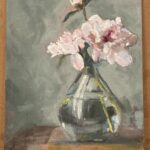
It is a real course that trains you in a structured way

Read more “It is a real course that trains you in a structured way”
I started learning oil painting with VAA from scratch. Just one year later my paintings started to sell

‘Ladder of Learning’ adds to overall positive experience of this awesome course

Read more “‘Ladder of Learning’ adds to overall positive experience of this awesome course”
The equivalent of a 4 year art education at a fraction of the cost

Read more “The equivalent of a 4 year art education at a fraction of the cost”
It is impossible to fail or gain little through extensive 4 year study at VAA!

Read more “It is impossible to fail or gain little through extensive 4 year study at VAA!”
